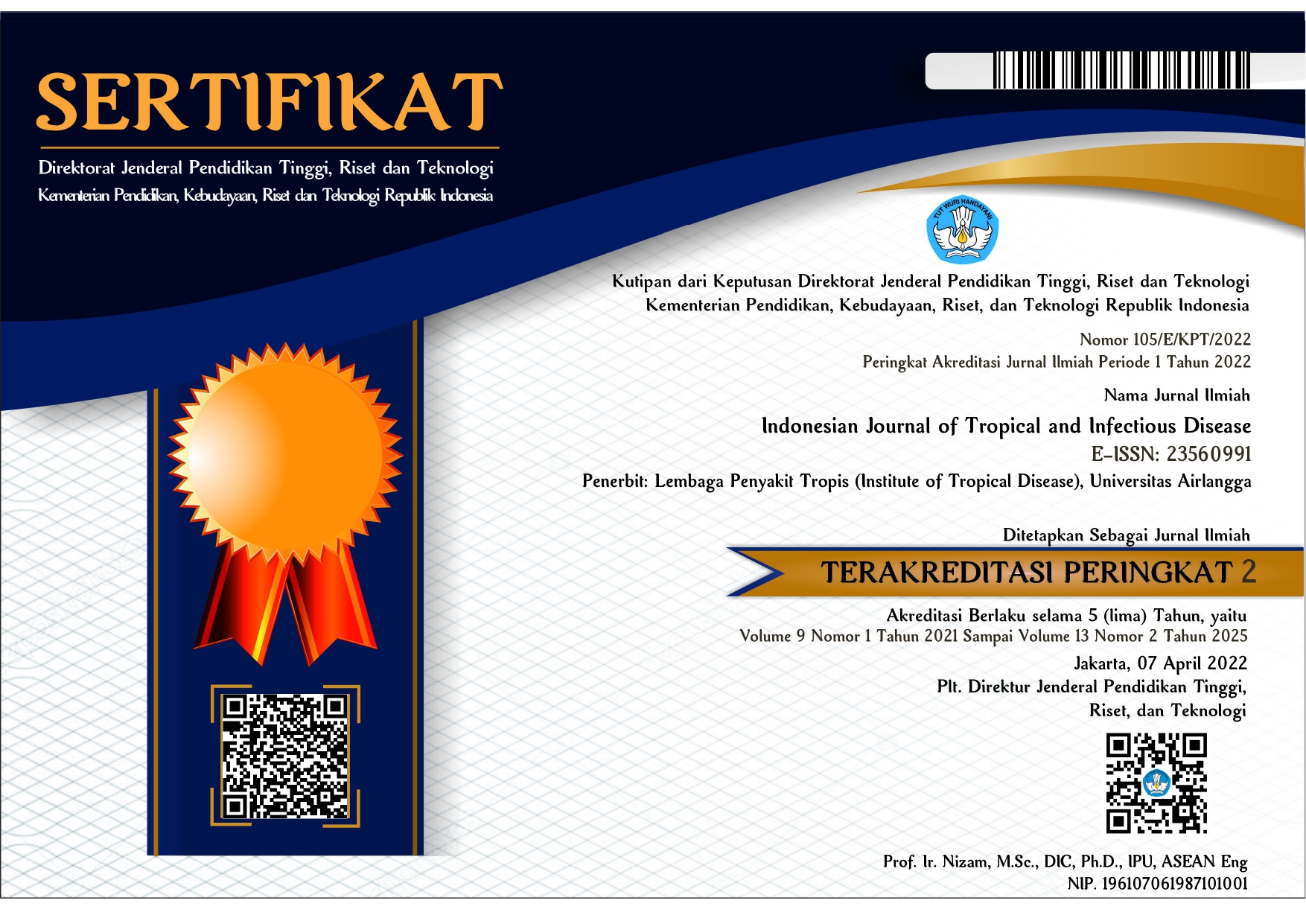Diagnosis Approach of Endobronchial Tuberculosis: Literature Review
Downloads
Pulmonary tuberculosis (PTB) remains a global health problem and the leading cause of death from infectious diseases. Indonesia as an endemic country and the second highest contributor of PTB cases in the world provides support and attention to PTB case finding and treatment success. Endobronchial tuberculosis (EBTB) is problematic PTB because the lesions are often not detected by sputum examination and chest X-ray. Clinically, there is no significant difference in symptoms between TB and EBTB. In general, EBTB gives a more severe clinical appearance due to airway stenosis. Bronchoscopy and thoracic computed tomography scan (CT scan), along with microbiological investigations, are the most useful diagnostic tools for confirming and evaluating tracheobronchial stenosis. In addition, bronchoscopy can also be used as a longterm treatment in cases of EBTB due to airway stenosis. The goals of treatment are the eradication of Mycobacterium tuberculosis (Mtb) bacilli with antituberculosis drugs (ATD) and the prevention of airway stenosis. Intervention of bronchoscopic techniques and surgery are required for those patients who develop severe tracheobronchial stenosis that causes significant symptoms, including dyspnea, repeated post-obstructive pneumonia or bronchiectasis. The most common complications of EBTB are airway stenosis, atelectasis, hemoptysis and shortness of breath accompanied by wheezing despite the administration of ATD. Bronchoscopic intervention can support the acceleration of EBTB treatment, prevent repeated hospitalizations and improve the quality of life of patients. Acceleration of diagnosis and administration of ATDs in a complete and routine way is expected to reduce morbidity and even mortality rates in EBTB cases.
World Health Organization (WHO). Global Tuberculosis Report 2022. Geneva; 2022.
Laporan Program Penanggulangan Tuberkulosis Tahun 2022 KEMENTERIAN KESEHATAN REPUBLIK INDONESIA TAHUN 2023. Available from: https://tbindonesia.or.id/wpcontent/uploads/2023/09/Laporan-Tahunan-Program-TBC-2022.pdf
Siow WT, Lee P. Tracheobronchial tuberculosis: a clinical review. J Thorac Dis [Internet]. 2017 [cited 2024 Jul 10];9(1):E71. Available from: /pmc/articles/PMC5303096/
Su Z, Cheng Y, Wu Z, Zhang P, Chen W, Zhou Z, et al. Incidence and Predictors of Tracheobronchial Tuberculosis in Pulmonary Tuberculosis: A Multicentre, Large-Scale and Prospective Study in Southern China. Respiration [Internet]. 2019 Jan 30 [cited 2024 Jul 10];97(2):153–9. https://dx.doi.org/10.1159/000492335.
Ip. MS, Lam WK, So SY, Mok CK. Endobronchial Tuberculosis Revisited. Chest. 1986 May 1;89(5):727–30.
Rikimaru T, Kinosita M, Yano H, Ichiki M, Watanabe H, Shiraisi T, et al. Diagnostic features and therapeutic outcome of erosive and ulcerous endobronchial tuberculosis. Int J Tuberc Lung Dis. 1998 Jul;2(7):558-62.
Murgu AD, Colt HG, Mukai D, Brenner M. A Multimodal Imaging Guide for Laser Ablation in Tracheal Stenosis. Laryng, 2010;120(9): 1840-6.
Kim S, Eom JS, Mok J. Bronchoscopic Strategies to Improve Diagnostic Yield in Pulmonary Tuberculosis Patients. Tuberc Respir Dis (Seoul). 2024 Jul;87(3):302-8.
Schulte SC, Fischer S. Management of Tracheobronchial Stenoses. Zentralbl Chir. 2023 Jun; 148(3): 293-303.
Jung SS, Park HS, Kim JO, Kim SY. Incidence and Clinical Predictors of Endobronchial Tuberculosis in Patients with Pulmonary Tuberculosis. Respirology. 2015: 20(3):488-95.
Hoseini SHA, Ghalenavi E, Amini M. Clinical and Para-Clinical Presentation of Endobronchial Tuberculosis. J Cardiothorac Med .2015;3(4):371-4.
Samardzic N, Jovanovic D, Denic L, Milenkovic MR. Clinical Features of Endobronchial Tuberculosis. Vojno Pregled. 2014;71(2):156-60.
Liu X, Xu L, Jiang G, Huang S. Pleural Effusion Resulting from Bronchial Tuberculosis. Medic. 2018; 97(40). 1-4.
Moon SM, Lee WY, Shin B. Clinical characteristics and drug resistance profile of patients with endobronchial tuberculosis in South Korea: single-center experience. Ann Palliat Med. 2023 May; 12(3):487-95.
Li Z, Mao G, Gui Q, Xu C. Bronchoplasty for Treating The Whole Lung Atelectasis Caused by Endobronchial Tuberculosis in Main Bronchus. J Thorac Dis. 2019;20(1): 71-7.
Natarajan A, Beena PM, Devnikar AV, Mali S. A systemic review on tuberculosis. Indian J Tuberc. 2020 Jul;67(3):295-311.
Lee P. Endobronchial tuberculosis. Indian J Tuberc. 2015 Jan1;62(1):7–12.
Akamatsu T, Shimoda Y, Saigusa M, Yamamoto A, Morita S, Asada K, et al. Use of virtual bronchoscopy to evaluate endobronchial TB. Int J Tuberc Lung Dis. 2021 Feb 1; 25(2): 145-7.
Martins J, Carvalho C, Freitas F, Monteiro P. Endobronchial tuberculosis. Port J Card Thorac Vasc Surg. 2022 Apr 11;29(1):83.
Kashyap S, Solanki A. Challenges in endobronchial tuberculosis: From diagnosis to management. Pul Medi. 2014;(2014): 1-8.
Cary C, Jhajj M, Cinicola J, Evans R, Cheriyath P, Gorrepati VS. A rare case of fibrostenotic endobronchial tuberculosis of trachea. Ann. Med. Surg. 2015;4(4):479-482.
Shahzad T, Irfan M. Endobronchial tuberculosis-a review. J. Thorac. Dis. 2016 Dec;8(12):3798-3802.
Panigrahi MK, Pradhan G, Mishra P, Mohapatra PR. Actively caseating endobronchial tuberculosis successfully treated with intermittent chemotherapy without corticosteroid: a report of 2 cases. Adv. Respir. Med. 2017;85(6):322-327.
Ahmad Z, Masood I, Baneen U, Ejaz S, Rehman S. Endobronchial growth: tumor or tuberculosis. J. Family Med. Prim. Care. 2024 Mar 6;13(2):792-796.
Esa NYM, Othman SK, Zim MAM, Ismail TST, Ismail AI. Brochoscopic features and morphology of endobronchial tuberculosis: A Malaysian tertiary hospital experience. J. Clin. Med. 2022 Jan 28;11(3):676
Kassam NM, Aziz OM, Somji S, Shayo G, Surani S. Endobronchial tuberculosis: A rare presentation. Cureus. 2020 May 8;12(5):e8033.
Peng S, Zhang G, Hong J, Ding H, Wang C, Luo J, Luo Z. Clinical and bronchoscopy features of tracheobronchial tuberculosis in children. Zhongguo Dang Dai Er Ke Za Zhi. 2023 Apr 15;25(4):381-387.
Dey A, Shah I. Infantile endobronchial tuberculosis. J. Family Med. Prim. Care. 2019 Jan;8(1):299-301.
Idrees F, Kamal S, Irfan M, Ahmed R. Endobronchial tuberculosis presented as multiple endobronchial vesicular lesions. Int. J. Mycobacteriol. 2015 Jun;4(2):154-7.
Rezaeetalab F, Farrokh D. Endobronchial tuberculosis in anthracotic bronchitis. Pneumologia. 2016 Jan-Mar;65(1):10-3.
Jioa A, Sun L, Liu F, Rao X, Ma Y, Liu X, Shen C, Xu B, Shen A, Shen K. Characteristics and clinical role of bronchoscopy in diagnosis of childhood endobronchial tuberculosis. World J. Pediatr. 2017 Dec;13(6):599-603
Nguyen-Ho L, Tran-Van N, Le-Thuong V. Central versus peripheral lesion on chest X-ray: A case series of 31 endobronchial tuberculosis patients with negative sputum smears. Int. J. Mycobacteriol. 2021 Jan-Mar;10(1):89-92.
Wahyuni TD, Alatas MF, Siahaan SS, Muljadi R, Carolline C. Bronchoscopic ballon dilatation for tuberculosis-related bronchial stenosis: A rare case. Respiratory Science. 2024;4(2):133-138.
Hanaoka J, Ohuchi M, Kuku R, Okamoto K, Ohshio Y. Bronchoscopic ballon dilatation combined with laser cauterization of high and long segmental tracheal stenosis secondary to endobronchial tuberculosis: A case report. Respir. Med. Case Rep. 2019 Jul 30;28:100917
Ichikawa Y, Kurokawa K, Furusho S, Nakatsumi Y, Yasui M, Katayama N. An effective case of bronchoscopic ballon dilatation for tuberculous bronchial stenosis. Respirol. Case Rep. 2023 Jul 18;11(8):e01191
Copyright (c) 2025 Indonesian Journal of Tropical and Infectious Disease

This work is licensed under a Creative Commons Attribution-NonCommercial-ShareAlike 4.0 International License.
The Indonesian Journal of Tropical and Infectious Disease (IJTID) is a scientific peer-reviewed journal freely available to be accessed, downloaded, and used for research. All articles published in the IJTID are licensed under the Creative Commons Attribution-NonCommercial-ShareAlike 4.0 International License, which is under the following terms:
Attribution ” You must give appropriate credit, link to the license, and indicate if changes were made. You may do so reasonably, but not in any way that suggests the licensor endorses you or your use.
NonCommercial ” You may not use the material for commercial purposes.
ShareAlike ” If you remix, transform, or build upon the material, you must distribute your contributions under the same license as the original.
No additional restrictions ” You may not apply legal terms or technological measures that legally restrict others from doing anything the license permits.























